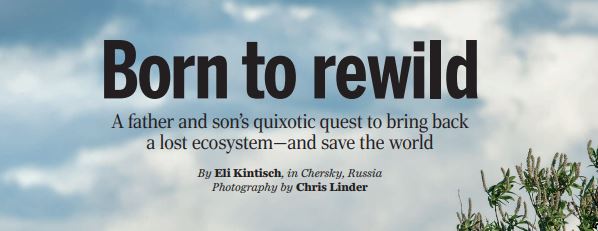1/ A glimpse into Pleistocene park for todays #rewildingscience tweet thread with the article “Born to #Rewild” by Eli Klintisch. This short article delves into the process and thoughts behind the attempts to re-establish the grassland-dominated ecosystem – the mammoth steppe 

2/ In the mid-90s, Sergey Zimov founded the Pleistocene park, a 14,000-hectare reserve near Chersky. The intention was to test whether large herbivores, such as, elk moose, reindeer, horses and bison – through grazing - could bring back the mammoth steppe landscape
3/ This biome dominated Northern Eurasia and North America for 2m years until the last glacial around 13,000 years ago when it shifted to mossy tundra. Why Zimov felt the need to re-establish this landscape lies in its carbon-trapping properties
4/ Zimov and colleagues estimated 1 trillion tons of carbon is contained in the Northern hemisphere permafrost, which threatens to leak out into the atmosphere. He proposed #rewilding using large herbivores to keep the permafrost intact, even as the atmosphere warms
5/ The theory as to why arctic megafauna died out at the end of the Pleistocene was brought into question. Rather than changing climate Zimov proposed herbivores had maintained the steppe and that the land only turned to tundra when their numbers fell for other reasons - hunting
6/ This was investigated by penning 25 Yakutian horses and watching how they quickly transformed mossy wet tundra into grassy pasture, disturbing the landscape, and lending weight to the argument that it is, infact, herbivores that influenced this ecosystem
7/ The implications of how megafauna can impact the landscape links back to the accumulation of organic material. The build up of plant material over hundreds of thousands of years means that the Yedoma soil is one of the most carbon rich on the planet…
8/ This is preserved under the tundra, deep-frozen in permafrost, however Zimov and colleagues warned that thawing could release this trapped carbon. By rewilding with large herbivores and insulating this permafrost, carbon-rich ice wedges would be kept from melting 

9/ This release could be up to 500 billion tons of carbon within a century, with methane release resulting in an additional 0.3 degree C increase by 2100. Raising funds to combat this in the park has been a problem, the author writes…
10/ Maintaining the herbivore population has been an issue, due to predation, exposure, or through the mentioned lack of funding. At the time of writing 70 animals roamed the park, instead of the 1000 Zimov envisioned…
11/ Despite this, the browsers are helping. By increasing grasses the vegetation is acting as a more effective insulator in the summer. Additionally, in the winter, when snow blankets the landscape, herbivores keep the ground exposed to the artic air and compacted
12/ Temperature loggers show average permafrost temperatures are 2 degrees C lower in grazed areas. However, others suggest that, in higher temps, sweeping away snow could allow soil to be warmed up more quickly. Arguments are that more robust models are needed to support Zimov..
13/ ...“This is an experiment that must be continued for tens of years”. Expansions for Pleistocene park’s fenced area are planned in addition to the establishment of a 300-hectare site near Moscow. This too is filled with herbivores to simulate the mammoth steppe
14/ As quoted in the article, one ecologist writes that “other than cutting global…emissions, no solution, apart from Zimov’s, have emerged to address the…prospect of permafrost carbon release”. We would love to hear your thoughts on this!
15/ A slight deviation from the standard paper review, this is an interesting read into the journey of Pleistocene park and the direction it may take in the future. Please read the full article here: reviverestore.org/wp-content/upl…
• • •
Missing some Tweet in this thread? You can try to
force a refresh









